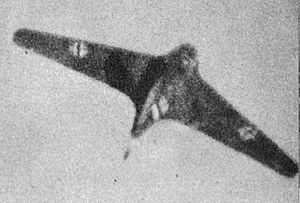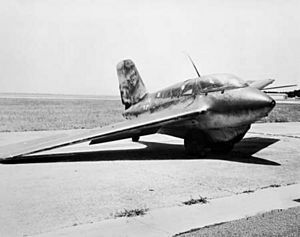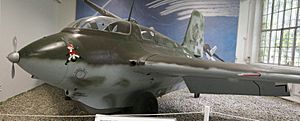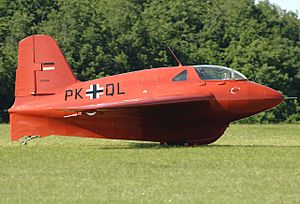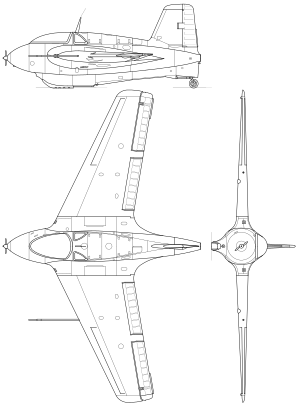Messerschmitt Me 163 Komet facts for kids
class="infobox " style="float: right; clear: right; width: 315px; border-spacing: 2px; text-align: left; font-size: 90%;" ! colspan="2" style="text-align: center; font-size: large; padding-bottom: 0.3em;" | Me 163 Komet |-
|- | colspan="2" style="text-align: center;" | 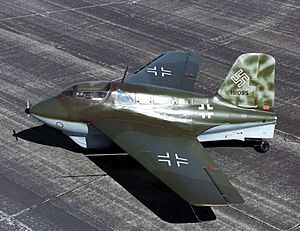 |- |colspan="2" style="border-bottom: 1px solid #aaa;text-align:center;" |Me 163B on display at the National Museum of the United States Air Force |-
|- |colspan="2" style="border-bottom: 1px solid #aaa;text-align:center;" |Me 163B on display at the National Museum of the United States Air Force |-
! Role | Interceptor |- ! National origin | Germany |- ! Manufacturer | Messerschmitt |-
! Designer | Alexander Lippisch |-
! First flight | 1 September 1941 |- ! Introduction | 1944 |-
! Primary user | Luftwaffe |-
! Number built | ~370 |-
! Developed into | Messerschmitt Me 263 |- |}
The Messerschmitt Me 163 Komet was a special kind of airplane. It was a rocket-powered interceptor aircraft, which means it used a rocket engine to fly very fast and stop enemy planes. It was designed and built by a German company called Messerschmitt. The Komet is famous for being the only rocket-powered fighter plane ever used in combat. It was also the first plane to fly faster than 1,000 kilometers per hour (620 mph) in level flight!
The idea for the Me 163 started in 1937 with a German engineer named Alexander Lippisch. He worked with a group called the Deutsche Forschungsanstalt für Segelflug (DFS), which means "German Research Institute for Gliding Flight." They first experimented with glider designs and then added a rocket engine. In 1939, Lippisch and his team moved to Messerschmitt. They decided to focus only on rocket power. The first prototype plane flew on September 1, 1941. It showed amazing speed and design. Leaders were very impressed and wanted to build many Me 163s to defend Germany. In December 1941, work began on an improved version, the Me 163B, which was easier to build in large numbers.
In July 1944, German test pilot Heini Dittmar flew the Me 163B at an incredible 1,130 km/h (702 mph). This was an unofficial speed record that no other jet plane could beat until 1953! Later that year, the Me 163 started flying real missions. Its main job was to protect against enemy bombing raids. Germany even shared its designs and one Me 163 with Japan. This helped Japan create its own rocket plane, the Mitsubishi J8M. By the end of World War II, about 370 Komets were built. Most of them were used in combat. However, the plane had some problems. It could only fly with its rocket engine for about seven and a half minutes. This meant it couldn't fly very far, which limited how useful it was. People tried to make better versions, like the Messerschmitt Me 263, but these new planes didn't see much combat. This was because the Allied forces were advancing quickly into Germany in 1945.
The Me 163 was a special plane, but it wasn't as successful in combat as hoped. It was credited with shooting down between nine and 18 Allied planes, but ten Komets were lost. Many Me 163 pilots also died during testing and training. This was partly because the rocket fuel was very dangerous. It was highly explosive and could burn skin. One pilot, Josef Pöhs, died in 1943 after an accident where a fuel line broke. Besides Germany, no other country used rocket planes like the Me 163 in combat. However, some captured Me 163s were flown by other countries for research.
Contents
Flying the Komet in Battle
The first tests of the Me 163A happened in late 1942. A special test unit called Erprobungskommando 16 (EK 16) was formed. They received their first eight Me 163A planes by July 1943. Their first base was at Peenemünde-West. After an air raid, they moved to Anklam and then to Bad Zwischenahn. EK 16 got their first armed Me 163B planes in January 1944. They were ready for action by May. Major Wolfgang Späte flew the first Me 163B combat mission on May 13, 1944.
When the Me 163B started flying in May 1944, its amazing speed surprised Allied fighter pilots. The Komets attacked alone or in pairs. They were often faster than the enemy fighters could dive. A common tactic was to fly straight up through the bombers at 9,000 meters (29,500 ft). Then, they would climb even higher, to 10,700 to 12,000 meters (35,100 to 39,400 ft). After that, they would dive back through the enemy formation, firing their cannons. This gave the pilot two quick chances to shoot. Pilots said they could make four passes on a bomber if it was flying alone. There was an idea to use the Me 163 to crash directly into enemy planes, but this dangerous plan was never used. By early 1944, Allied planes flying over German airfields had already seen the Me 163.
Pilots who flew gliders were often chosen to train for the Me 163. They used a small glider called the Stummelhabicht to learn how the Me 163 handled. Training also included shooting practice with a machine pistol in the glider's nose. The Komet's cockpit was not pressurized. This meant pilots could only fly so high before the thin air became a problem. They had to train in special altitude chambers. This helped them get used to breathing oxygen at high altitudes. They also ate special low-fiber diets. This was because gas in their stomachs would expand quickly as they climbed.
After the first combat tests, Major Späte created the first dedicated Me 163 fighter group. It was called Jagdgeschwader 400 (JG 400). It was based in Brandis, near Leipzig. JG 400's job was to protect the Leuna factories. These factories made synthetic fuel and were often bombed in 1944. Another group was stationed at Stargard Szczeciński to protect a large fuel plant at Pölitz. Plans were made for more rocket fighter units in other German cities.
The Me 163B first saw regular combat on July 28, 1944. Two USAAF B-17 Flying Fortress bombers were attacked, but no confirmed kills were made. Combat missions continued from May 1944 to spring 1945. During this time, nine enemy planes were shot down, and ten Me 163s were lost. Feldwebel Siegfried Schubert was the most successful pilot, shooting down three bombers. In each battle, up to a dozen Me 163s would launch to fight the B-17s.
Allied fighter pilots soon noticed that the Me 163 could only fly with its engine on for a short time. They changed their tactics to use this to their advantage. They would wait until the Komet's engine ran out of fuel. Then, they would attack the unpowered plane. Even without power, the Komet was very easy to maneuver. This made it a hard target to shoot down. Another Allied tactic was to attack the airfields where the Komets operated. They would shoot at the planes after they landed. The Komet landed on a skid, not wheels. This meant it couldn't move by itself. A special tractor called the Scheuch-Schlepper had to tow it back to its maintenance area.
By the end of 1944, 91 Komets had been given to JG 400. But most of them stayed on the ground because there wasn't enough fuel. It became clear that the plan for many Me 163 bases would not happen. So far, JG 400 had lost only six planes to enemy action. Nine Me 163s were lost for other reasons. This was a small number for such a new and advanced aircraft. In early 1945, the Me 163 continued to defend important targets, like the Daimler Benz tank factory in Berlin. In the last days of the war, the Me 163 was replaced by the more successful Messerschmitt Me 262. In May 1945, Me 163 operations stopped. JG 400 was disbanded, and many of its pilots went to fly Me 262s.
Overall, the Komet was not a success in combat. It shot down sixteen planes, mostly large bombers. But it didn't make up for all the effort put into building it. Because of fuel shortages late in the war, few Komets actually fought. It also took a very skilled pilot to get a kill. However, the Komet did inspire later weapons. These included the rocket-powered Bachem Ba 349 Natter and the American Convair XF-92 jet interceptor. Eventually, surface-to-air missiles (SAMs) took over the job of defending specific areas.
Post-War Flights
Captain Eric Brown, a British test pilot, flew the Me 163 at Farnborough after the war. He said, "The Me 163 was an aeroplane that you could not afford to just step into the aircraft and say 'You know, I'm going to fly it to the limit.' You had very much to familiarise yourself with it because it was state-of-the-art and the technology used." Even though it was officially discouraged, Brown wanted to fly a Komet with its engine on. Around May 17, 1945, he flew an Me 163B at Husum. German ground crew helped him. He first flew towed Me 163A gliders to get used to how it handled.
The day before the flight, Brown and his crew checked the engine to make sure it worked. The German crew were worried something might happen to Brown. So, he signed a paper saying they were acting under his orders. The next day, when he took off with the rocket engine, Brown said it was "like being in charge of a runaway train." The plane reached 9.76 kilometers (32,000 ft) in just 2 minutes and 45 seconds. During the flight, he practiced attacking an American B-17 bomber. He was surprised how fast the Komet sped up when diving, even with the engine off. When the flight was over, Brown landed easily. The view from the cockpit was a bit limited, but the plane touched down at 200 km/h (124 mph). After landing safely, Brown and his relieved crew celebrated.
The British never tested the Me 163 with its engine on after Brown's flight. This was because its fuel was so dangerous. Brown did fly the Komet as a glider many times. Its rocket motor was replaced with test equipment. Brown said that out of five tailless planes he flew, the Komet was the only one that had "good flight characteristics."
Surviving Aircraft
It is believed that at least 29 Komets were sent out of Germany after the war. At least 10 of them are still around today in museums. Most of the 10 surviving Me 163s were part of JG 400. The British captured them at Husum when Germany surrendered in 1945. The RAF museum says 48 planes were captured whole. 24 were sent to the United Kingdom for study, but only one was tested as a glider.
Australia
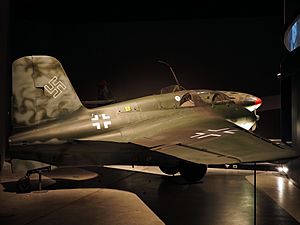
- Me 163B, Werknummer 191907, was part of JG 400. It was captured at Husum and sent to the RAE in England. It was given the RAF number AM222. In 1946, it was sent to Australia. For many years, this plane was shown at RAAF Williams Point Cook. In 1986, the Me 163 was moved to The Australian War Memorial for repair. It is now on display there with a Messerschmitt Me 262.
Canada

- Me 163B, Werknummer 191659 (AM215) or 191914 (AM220), is at the Canada Aviation and Space Museum in Ottawa. Like some British Komets, this plane was part of JG 400 and captured at Husum. It was sent to Canada in 1946.
Germany
- A Me 163B, Werknummer 191904, "Yellow 25", was captured by the RAF at Husum in 1945. It was sent to England and then displayed at a museum at RAF Colerne. When that museum closed, the plane went to RAF St Athan. In 1988, the plane was returned to the German Luftwaffe. It was moved to a factory at the air base in Oldenburg. The plane was in good shape, but the cockpit was empty, and the rocket engine was missing.
Later, an older German woman came forward with Me 163 instruments that her husband had collected. The engine was rebuilt by a workshop owned by a Me 163 fan. The factory closed in the early 1990s. "Yellow 25" was moved to a small museum there. In 1997, "Yellow 25" moved to the official Luftwaffe Museum at Berlin-Gatow. It is displayed there today with a restored Walter HWK 109–509 rocket engine. This Me 163B is one of the few World War II German planes in a German museum that still has a swastika marking on its tailfin.
- Me 163B, Werknummer 120370, "Yellow 6" of JG 400, is shown at the Deutsches Museum in Munich. It was first sent to Britain and given the RAF number AM210. It was given to the Deutsches Museum by RAF Biggin Hill Station.
United Kingdom
Out of the 21 planes captured by the British, at least three have survived. They were given British serial numbers from AM200 to AM220.
- Me 163B, Werknummer 191316, "Yellow 6", has been on display at the Science Museum in London since 1964. Its Walter motor is shown separately.
- Me 163B, Werknummer 191614, is now displayed at the RAF Museum London. It used to be at the RAF Museum Cosford. This plane last flew on April 22, 1945, when it shot down an RAF Lancaster bomber.
- Me 163B-1a, Werknummer 191659 and RAF serial number AM215, "Yellow 15", was captured at Husum in 1945. It was sent to the College of Aeronautics at Cranfield, England, in 1947. After many years of being shown at airshows, it was loaned to the National Museum of Flight at East Fortune Airfield, Scotland, in 1976.
United States

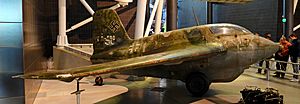
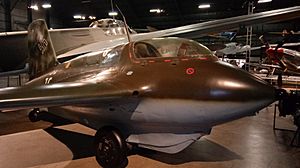
- Five Me 163s were brought to the United States in 1945. They were given numbers like FE-495 and FE-500 to 503. An Me 163 B-1a, Werknummer 191301, arrived at Freeman Field, Indiana, in mid-1945. It was given the number FE-500. On April 12, 1946, it was flown to Muroc dry lake in California for flight testing. Tests began on May 3, 1946. They involved towing the Komet behind a Boeing B-29 Superfortress to a high altitude. Then, it was released to glide back to earth. Powered tests were planned but not done. This was because the plane's wooden wings were found to be coming apart. It was then stored until 1954. It is now on display at the National Air and Space Museum's Steven F. Udvar-Hazy Center near Washington D.C..
- Me 163B, Werknummer 191 095, is fully restored and displayed at the National Museum of the United States Air Force near Dayton, Ohio. It was bought from the Canadian National Aviation Museum. It was put on display on December 10, 1999. Komet test pilot Rudolf "Rudi" Opitz was there for the event. He talked about his experiences flying the rocket fighter. During the plane's restoration in Canada, it was found that French forced laborers had built it. They had purposely put stones between the rocket's fuel tanks and straps. This was an act of sabotage. They also used bad glue for the wing. Patriotic French writing was found inside the plane.
- Me 163B, Werknummer 191660, "Yellow 3", is owned by Paul Allen's Flying Heritage Collection. From 1961 to 1976, this plane was displayed at the Imperial War Museum in London. In 1976, it moved to the Imperial War Museum Duxford. It was restored starting in 1997. In May 2005, it was sold to raise money for another plane.
Japanese Versions
Germany shared plans and an example of the Me 163 with Japan. However, one of the two submarines carrying Me 163 parts did not reach Japan. So, the Japanese did not have all the main parts or building plans. They had to figure out how to build their own design from a manual they got from Germany. The first Japanese prototype, the J8M, crashed on its first powered flight and was destroyed. But several versions were built and flown. These included trainers, fighters, and interceptors. They had only small differences.
The Navy's version, the Mitsubishi J8M1 Shūsui, used different cannons. Mitsubishi also planned to make a version of the 163C for the Navy, called the J8M2 Shūsui Model 21. A version of the 163 D/263 was known as the J8M3 Shusui for the Navy. The Army had a version called the Ki-202 Shūsui-kai. Trainers were also planned. These were gliders like the Kugisho/Yokosuka MXY8 Akigusa and jet-powered trainers like the Kugisho/Yokosuka MXY9 Shūka.
One complete Japanese plane is at the Planes of Fame Air Museum in California. The body of a second plane is displayed at the Mitsubishi company's museum in Japan.
Replicas
A flying replica of the Me 163 was built between 1994 and 1996. It was made by Joseph Kurtz, a former German pilot who trained to fly Me 163s. He later sold the plane to EADS. This replica is a glider. It looks like an Me 163, but it is built differently. The glider is made of wood and weighs only 285 kg (628 lb). This is much lighter than the original plane. It is said to fly very well. The glider is painted red, like the Me 163 flown by Wolfgang Späte. In 2011, it was still flying.
In the early 2000s, a rocket-powered replica called the Komet II was planned by XCOR Aerospace. This company had built other rocket planes. The Komet II would have looked like the original. But its design would have been very different for safety reasons. It would have been partly made of new materials. It would have used a simpler and safer rocket engine. It would also have had retractable landing gear instead of a takeoff dolly and landing skid.
Several non-flying replica Me 163s are shown in museums.
Specifications: Me 163B-1a
Data from The Warplanes of the Third Reich, Profile No225: Messerschmitt Me 163 Komet
General characteristics
- Crew: 1 pilot
- Capacity: (Me 163S + 1)
- Length: 5.7 m (18 ft 8 in)
- Wingspan: 9.3 m (30 ft 6 in)
- Height: 2.5 m (8 ft 2 in)
- Wing area: 19.6 m2 (211 sq ft)
- Empty weight: 1,905 kg (4,200 lb)
- Max takeoff weight: 4,309 kg (9,500 lb)
- Fuel capacity:
- C-Stoff (fuel) 468 kg (1,032 lb)
- T-Stoff (oxidiser) 1,550 kg (3,417 lb)
- Powerplant: 1 × Hellmuth Walter Kommanditgesellschaft HWK 109-509A-2 bi-propellant liquid-fuelled rocket motor, 14.71 kN (3,307 lbf) thrust maximum; 220 lbf (0.98 kN) minimum, fully variable
Performance
- Never exceed speed: 900 km/h (559 mph; 486 kn) at all altitudes, sea level to 12,000 m (39,000 ft)
- Flap limiting speed: 300 km/h (190 mph; 160 kn)
- Rotate speed at take-off: 280 km/h (170 mph; 150 kn)
- Best climbing speed: 700–720 km/h (430–450 mph; 380–390 kn)
- Endurance: 7.5 mins powered
- Rate of climb: 81 m/s (16,000 ft/min)
- Time to altitude: From standing start
- 2,000 m (6,600 ft) in 1.48 min
- 4,000 m (13,000 ft) in 2.02 min
- 6,000 m (20,000 ft) in 2.27 min
- 8,000 m (26,000 ft) in 2.54 min
- 10,000 m (33,000 ft) in 3.19 min
- 12,000 m (39,000 ft) in 3.45 min
- Wing loading: 209 kg/m2 (43 lb/sq ft) at maximum take-off weight
- Thrust/weight: 0.42
Armament
- Guns:
- 2 × 30 mm (1.181 in) Rheinmetall Borsig MK 108 cannon with 60 rounds per gun (B-1a)
-
-
- or
-
-
- 2 × 20 mm (0.787 in) MG 151/20 cannon with 100 rounds per gun (Ba-1 / B-0 pre-production aircraft)
Images for kids
-
Me 163B's unsprung jettisonable main gear "dolly" unit
-
Me 163 B-1a at the National Museum of Flight in Scotland
-
A preserved HWK 109-509B "cruiser" twin-chamber rocket motor (National Museum of the United States Air Force)
See also
 In Spanish: Messerschmitt Me 163 para niños
In Spanish: Messerschmitt Me 163 para niños
- Aircraft related to this one
- DFS-39
- DFS-194
- Messerschmitt Me 263
- Mikoyan-Gurevich I-270
- Mitsubishi J8M
- Similar aircraft
- Bachem Ba 349
- Bereznyak-Isayev BI-1
- Focke-Wulf Volksjäger
- Lists related to this aircraft
- List of aircraft of World War II
- List of military aircraft of Germany
- List of fighter aircraft
- List of rocket-powered aircraft
- List of World War II military aircraft of Germany
- Wunderwaffe


